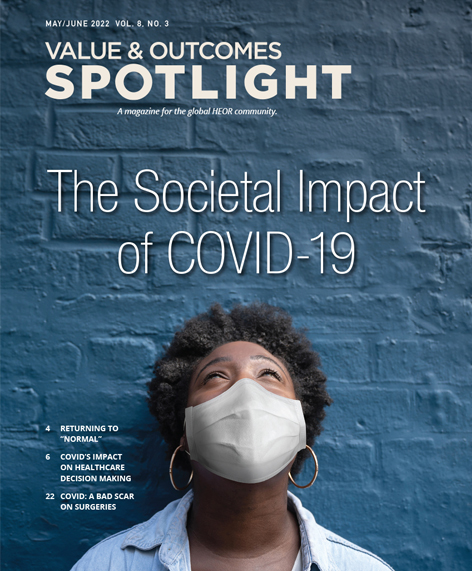The Challenges of Economic Analysis of COVID-19 Interventions: A Conversation With David D. Kim, PhD, MS
Section Editor: Marisa Santos, PhD, MD, Instituto Nacional de Cardiologia, Rio de Janeiro, Brazil
I had the opportunity to speak to David D. Kim, PhD, MS, Institute for Clinical Research and Health Policy Studies, Center for the Evaluation of Value and Risk in Health (CEVR), Tufts Medical Center, Boston, MA, USA, about the economic and societal impacts of COVID-19. We spoke about the challenges of conducting economic evaluations of COVID-related interventions and how HEOR methods and models can help inform decision making regarding the value of treatments, resource allocation, and health equity.
 VOS: The COVID-19 pandemic is devastating on the economy and society, causing human losses, suffering, and long-term consequences. You recently released a systematic review of economic evaluations of COVID-19 interventions. What were the most important nonhealth consequences of COVID-19?
VOS: The COVID-19 pandemic is devastating on the economy and society, causing human losses, suffering, and long-term consequences. You recently released a systematic review of economic evaluations of COVID-19 interventions. What were the most important nonhealth consequences of COVID-19?
David D. Kim: Undoubtedly, COVID-19 has made unfathomable health impacts, as the United States just reached more than one million COVID-related deaths, and globally, more than 6.2 million lives have been lost due to COVID-19. In the meantime, COVID-19 and interventions to prevent the spread of COVID-19, particularly nonpharmaceutical interventions (eg, stay-at-home orders and social distancing), have posed substantial nonhealth impacts, including lost productivity due to COVID-19, caregiver time, increases in unemployment, sluggish economic growth, lack of educational attainment due to remote learning, and changes in motor vehicle accidents and crimes. In our review of economic evaluations of COVID-19 interventions, the most common nonhealth impacts included lost productivity because of illness, changes in gross domestic product, and education impacts.
VOS: Despite the Second Panel’s recommendations, many HTA agencies and researchers failed to include nonhealth consequences. Why does that happen and why is it important to include these effects in economic analyses?
DK: A review of 45 international HTA guidelines revealed that most guidelines (67%) recommend either a narrower healthcare payer or healthcare sector perspective as the reference perspective, and the use of a broader societal perspective has not gained much traction. The lack of uptake for a societal perspective indicates some practical and analytic challenges—namely, the absence of strong incentives to consider nonhealth impacts among decision makers with explicit healthcare budgets, difficulties in changing established practices, and the lack of available data to quantify nonhealth impacts (eg, on informal caregiver time or nonlabor market productivity). Still, the lack of consideration for the nonhealth impacts of interventions could lead to an incomplete assessment of an intervention’s value and potentially result in a misallocation of healthcare resources.
VOS: What do you think is an essential target for future research in this area?
DK: The COVID-19 pandemic emphasized how health impacts are closely connected with broader social impacts. It is essential for economic evaluations to account for both health and nonhealth impacts to generate reliable and comprehensive evidence on trade-offs between effects on health, health-related costs, and nonhealth impacts. As a step forward, widespread use of the impact inventory and reporting disaggregate outcomes would provide the relevant information in a comprehensive, consistent, and transparent manner to guide decision makers with different preferences. Other emerging research areas include quantifying health equity impacts and addressing the equity-efficiency trade-offs; a better reflection of individuals’ risk preferences in economic evaluations; consistent and reliable measurement of novel elements of value (eg, option value, value of hope, and scientific spillovers); and accounting for implementation and behavioral factors to guide resource allocation decisions.
VOS: We now have antivirals that have been found to be effective against COVID-19. What is the most difficult aspect in evaluating and applying these cost-effectiveness studies?
DK: A key challenge in evaluating therapeutic interventions and vaccines against COVID-19 is how to assess the value of these interventions. Although cost-effectiveness analysis provides a useful value metric in the form of an incremental cost-effectiveness ratio, the choice of analytic perspective—that determines which costs and benefits should be considered—can influence the estimated cost-effectiveness ratio and subsequent reimbursement and coverage decisions. For example, ICER’s early assessment of remdesivir focused on a healthcare sector perspective, omitting potential nonhealth benefits of increasing the healthcare system’s capacity by reducing hospital length of stay. Although estimating the full value of COVID-19 interventions is difficult, an analysis accounting for the pandemic’s substantial nonhealth impact will serve as an important input into pricing discussions.
VOS: Another element of the COVID-19 epidemic is how it affects diverse groups of people. How do the COVID-19 economic models address questions of equality and the differential impact of nonpharmacologic interventions on vulnerable groups?
DK: We know vulnerable populations (eg, individuals with chronic conditions, those of economic disadvantage, and people of color) are more likely to experience adverse outcomes because of COVID-19. Nevertheless, our review found that most economic evaluations only reported summary outcomes at a population level. In addition, although a handful of studies reported summary measures stratified by age groups, only 2 explicitly focused on vulnerable populations, such as racial and ethnic minorities or individuals experiencing homelessness. None of the reviewed articles conducted distributional equity impact analysis. The dearth of distributional analyses is likely because of a lack of concrete estimates of the economic impacts of different initiatives on subgroups of interest. However, it is still imperative for researchers to apply a framework that could identify and mitigate the equity harms and to generate cost-effectiveness evidence for most vulnerable populations to guide targeted interventions to improve health equity.
VOS: How do you develop an economic model while dealing with the uncertainty of new virus variants and possible new waves of infection?
DK: During the pandemic, urgent public health decisions, such as whether and when to reopen schools or reinstate mask mandates, need to be made without sufficient data. Modeling has been at the forefront of informing such decisions by combining multiple data sources and assessing key assumptions. With substantial uncertainties in predicting the path of the COVID-19 pandemic, a few things would make pandemic models more useful. First, transparent reporting of key assumptions, justification of their choices, and their impacts on results (ie, robustness check) would be important to communicate. Second, iterative and adaptive modeling to reflect emerging situations and uncertainties, along with updating data inputs, is needed. Open-source models can play a key role in expanding the usability and adaptability of pandemic models. Finally, when multiple models exist, comparative modeling, which combines forecasts from multiple models into a single “ensemble” forecast, could provide more reliable and accurate predictions, as highlighted by the US COVID-19 Forecast Hub.

